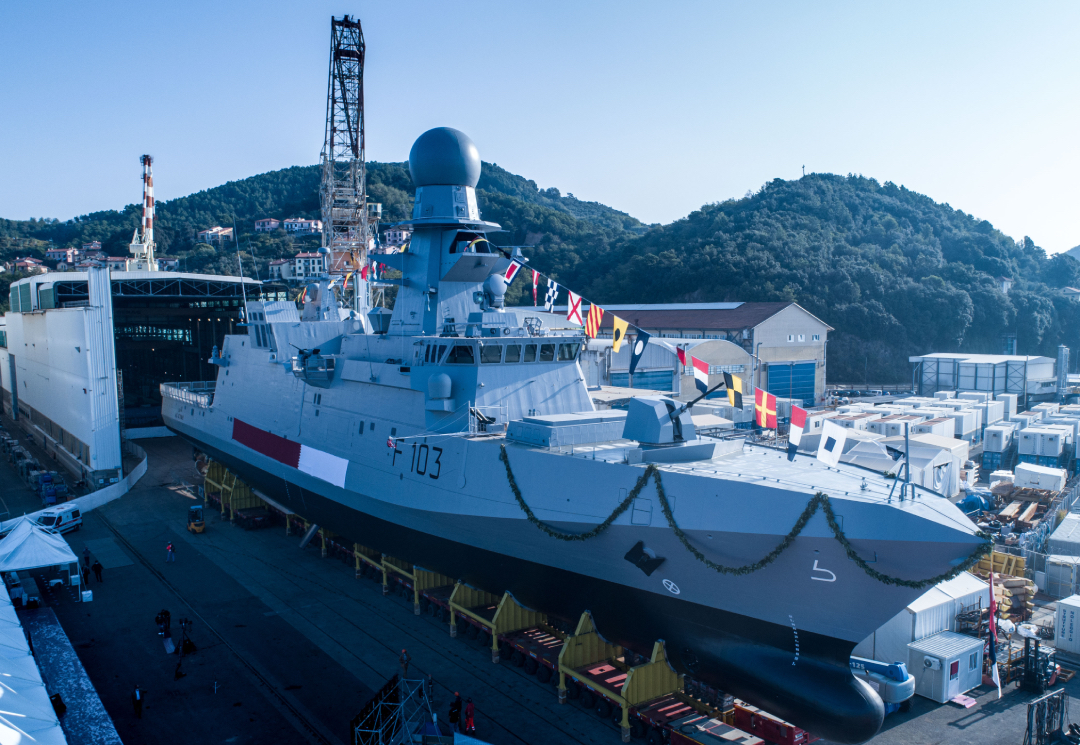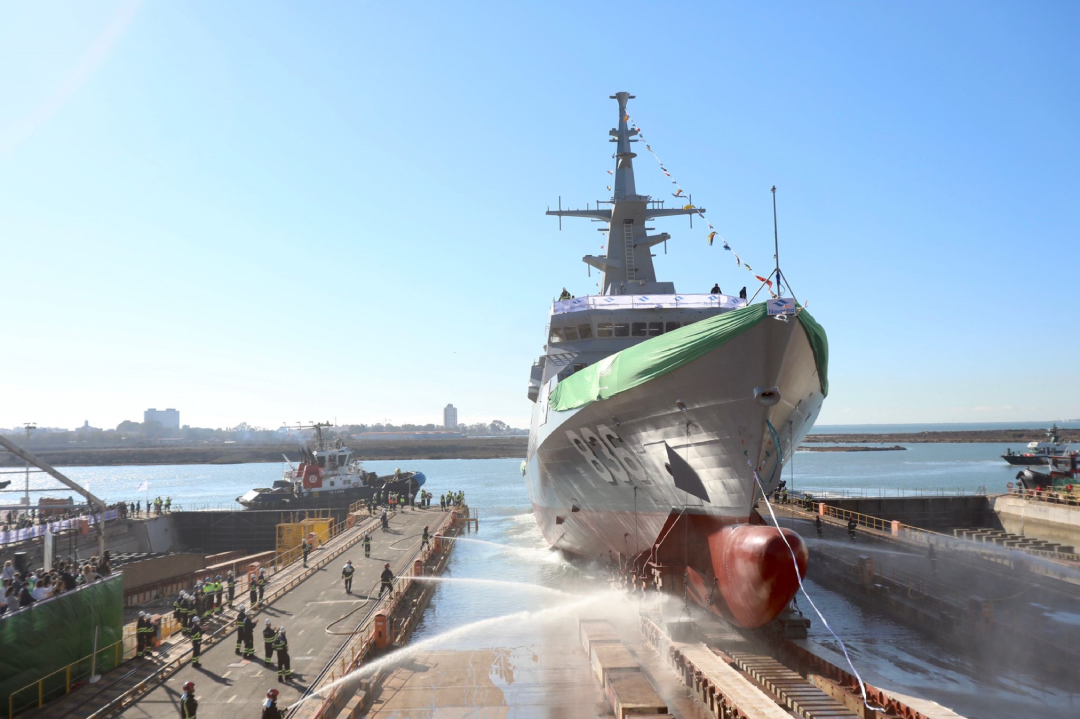
Gulf states have been investing defence budgets in to recapitalise naval power as well as indigenous shipyards.
Disputes in the Gulf and wider Middle East over recent years has been the main driver for a rise in defence expenditure and efforts to enhance the capability of military forces.
Rivalry between Islamic Republic of Iran and the Kingdom of Saudi Arabia is one of the main causes of friction in the region but there is also quarrelling between the Gulf Cooperation Council (GCC) countries – called the intra-GCC rift – that has further inflamed tensions.
GCC countries comprise Saudi Arabia, Qatar, Kuwait, the Sultanate of Oman, the Kingdom of Bahrain and the United Arab Emirates. These states occupy one of the most important strategic waterways in the world that can control access to the Persian Gulf and global oil supplies, therefore it is of interest to the major powers.
Saudi Arabia and Qatar have been struggling for dominance since the Arab Spring in 2011 when the governments in Riyadh and Doha took opposing sides and have also supported different groups in Libya, Egypt, Syria, Bahrain and in the ongoing Yemen Civil War. Although these neighbours have never come to direct blows, they are each striving to use their influence to promote their own interests above the other.
According to Tom Waldwyn, a research analyst for defence and military analysis at the International Institute for Strategic Studies (IISS), naval modernisation efforts in the GCC countries have gone towards recapitalising surface combatant fleets with new multirole frigates and corvettes.
“Several countries have also begun expanding the size and capabilities of maritime law enforcement forces likely due to greater instability at-sea resulting from the Yemen Civil War,” he told AMR, but added that Gulf state maritime modernisation “does not cover as great an extent of capabilities as procurement efforts in other domains.”
This is because any existential threat to the controlling regimes in these countries can only come from a land invasion to depose them and consequently investment has focussed on land and air procurement as a priority. Despite this preference naval procurement has seen significant funding.
Naval expansion
The Qatari Emiri Navy (QEN) has expanded considerably over the past decade as part of the wider modernisation of Qatar’s defence forces where billions have been spent on new fighter aircraft. Italian shipbuilder Fincantieri has been the main beneficiary on the naval side – the company signed a contract in June 2016 worth an estimated $3.9-5.6 billion (€3.5-5 billion) to provide the QEN with new ships to drastically enhance its naval capabilities.
“Qatar’s $5.65bn contract with Fincantieri for corvettes, offshore patrol vessels (OPVs) and an amphibious assault ship (a separate contract with Leonardo will provide helicopters) will provide the most significant naval upgrade on an existing fleet in the region and will present numerous challenges including training, infrastructure and operations,” Waldwyn said.
In 2018 Qatar ordered 28 NHI NH90 helicopters, 12 of which are NATO Frigate Helicopter (NFH) naval variants. Leonardo announced on 3 January 2022 that the first NFH variants will be delivered ‘soon after qualification in the coming months’ following the delivery of the Qatar Emiri Air Force’s first TTH variant on 11 December. Deliveries will be completed in 2025.
In October 2021, Fincantieri delivered the first of four new Al Zubarah-class (formerly Doha-class) air defence corvettes to the QEN. The second ship, Damsah, was launched in February 2021, along with keel laying for the fourth vessel, Sumaysimah. Ship 3, Al Khor, was launched in October 2021 and deliveries are expected in 2022-2023.

At the same event, Fincantieri also launched the first of the two new OPVs for the QEN. Named Musherib, the OPV is due to be delivered at the end of January 2022 as AMR went to press. The second OPV, Sheraouh, was launched in June 2021 and is also due for delivery in mid-2022. Qatar wants these new vessels in-service by the start of the 2022 Football World Cup tournament. Construction of the new landing platform dock (LPD) amphibious ship started at Fincantieri’s Palmero facility and will be launched at the end of 2022 before a handover at Muggiano in 2024.

Until recently the QEN consisted of a handful of Barzan-class fast attack craft. The QEN has also received 17 patrol craft from Ares Shipbuilding in Turkey and it received the Al Doha training ship from Anadolu Shipyard, also a Turkish yard in August 2021. A second training ship, Al Shamal, due in 2022. Integrating all these new platforms, sensors and weapons is going to be difficult for a country of 2.3 million people. Qatar has also expanded its General Directorate of Coastal and Border Security (GDCBS) which opened a new based in Al Daayen in July 2019 and has received a new fleet of 48m-long patrol ships from Turkish shipbuilder Ares Shipyard.
In terms of spending Saudi Arabia is providing the largest sums to the Royal Saudi Navy Forces (RNSF) and it is one of the biggest defence spenders globally. It has a series of projects under its Saudi Naval Expansion Programme II (SNEP II) that is worth in excess of $20 billion.
“Saudi Arabia has approximately $10bn worth of ongoing naval and coast guard procurement with the most valuable programme being the $6bn Multi Mission Surface Combatant (MMSC) programme, with Lockheed Martin, to acquire four frigates based on the Freedom-class Littoral Combat Ship (LCS) design,” Waldwyn said. “These will likely replace the four 1980s-era Madina-class frigates.”
The MMSC contract was signed in October 2016 under a Foreign Military Sales (FMS) agreement with the US. Lockheed Martin’s Marinette Marine shipyard started construction of the first frigate, named Saud, in October 2019 and began work on the second ship in January 2021.
Meanwhile in December 2021, Spanish shipbuilder Navantia launched Unayzah, the fifth and final Avante 2200 corvette for the RNSF under the Al-Sarawat programme. A contract $2 billion for the quintet was signed between the Saudi Arabian Military Industries (SAMI) organisation in July 2018. Unayzah will be delivered in February 2024. The fourth ship, Jazan, was launched in July 2021.

“Saudi Arabia’s deal with Navantia for Avante 2200 frigates includes the establishment of a joint venture to work on a combat management system and sales of it in the region but does not include shipbuilding work or offsets,” Waldwyn explained. The SAMINavantia joint venture undertook project management and development work. The new CMS is named HAZEM that was developed with technology transfer from Navantia and is part of Riyadh’s ‘Saudi Vision 2030’ effort to spend at least 50 percent of its defence budget in-country.
Earlier plans to build the fourth and fifth frigates in Saudi Arabia under the SAMINavantia Joint Venture (JV) appear to have come to nothing as there is no naval shipbuilding industry in the country and it was likely too costly to set up a new shipyard. However final integration of a combat management system and delivery of Jazan and Unayzah will be completed by the JV in Saudi Arabia.
Waldwyn said that despite the lack of a shipbuilding sector that a Saudi Coast Guard contract signed in 2018 with French shipbuilder CMN Group for 39 HSI32 interceptor patrol vessels does include the assembly “of 20 of them in Saudi Arabia by Zamil Offshore Services” at its Dammam yard. This could indicate the first steps in developing some initial form of local industrial capability.
The third GCC country experiencing a naval build-up is the UAE, which is acquiring new surface combatants and an amphibious vessel that Waldwyn said being used to “reinforce operations in Yemen as well as Emirati bases in Africa” as a close ally of Saudi Arabia. It is also the only country that is developing its own naval industrial base through Abu Dhabi Shipbuilding (ADSB). The company built six Baynunah-class corvettes for the UAE Navy delivered in the early 2010s although it still had to acquire the major systems, sub-systems and weaponry from overseas.
In May 2021, ADSB announced that it has signed a $952 million (AED3.5 billion) contract with the UAE to build four Falaj 3-class OPVs for the UAE Navy. The Falaj 3 design is based on the Fearless-class patrol ship design from Singaporean shipbuilder ST Engineering. In November 2021 ST Engineering won a sub-contract from ADSB to supply design, platform equipment and technical assistance on the programme.
Earlier in February 2021 another UAE shipbuilder, Al Fattan Group, completed delivery of the Al Saadiyat (L72) logistics ship that was commissioned into the UAE Navy. Although based on a landing craft it will provide the UAE Navy with the ability to conduct expeditionary operations and support the UAE’s overseas ambitions.
Meanwhile in December 2021, French shipbuilder Naval Group launched, Bani Yas, the first of a pair of new Gowind 2500 corvettes for the UAE Navy. The second ship is due to be launched in 2022 and the pair will be commissioned within six months of each other. The contract for the pair was signed in 2019.
Elsewhere in the GCC there has been little naval development in recent years. The Royal Navy of Oman completed its fleet re-capitalisation effort with the procurement of three Khareef-class corvettes from BAE Systems and four Al Ofouq-class patrol ships from ST Engineering in the early 2010s and in its 2021 budget it has reduced defence expenditure. Waldwyn said that Bahrain and Kuwait have small navies that have seen “limited recent modernisation” because “other services have been prioritised.” Bahrain hosts the US Fifth Fleet at Manama, which gives the island state a certain amount of maritime security it would not otherwise possess. That said, the Bahrain Naval Force commissioned Al Zubara, a former UK Royal Navy River-class patrol ship into service in February 2021 along with two 35m-long Fast Patrol Vessels from US shipbuilder Swiftships and five ex-US Navy MkV patrol boats.
Looking ahead the GCC countries are likely to continue to source the majority of their naval platforms and systems from the US and Europe and these companies will secure the lion’s share of the lucrative contracts. Waldwyn said there have been some modest sales to the GCC from outside its traditional American and European supplier network but “these were based on political relationships rather than winning in open competition. “Gulf states may diversify their suppliers but will continue to import complex naval vessels into the near future.”
He added that the efforts to grow the local defence industry, “most noticeably in Saudi Arabia and the UAE, through offset agreements and joint ventures will likely mean some growth in shipbuilding, or subsystem manufacture, capability by the end of the decade.”
by Tim Fish










